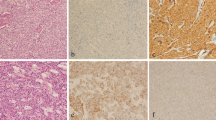Abstract
Background
Basal-like breast carcinomas often are regarded for circumscribed solitary lesions having unfavorable prognosis. On the other hand, a considerable proportion of breast carcinomas is multifocal and has increased metastatic potential. In this study, we analyzed the subgross distribution of the lesions in a series of basal-like carcinomas, compared it with that in nonbasal-like tumors and studied the frequency of vascular invasion and lymph node metastasis in relation to focality of the lesions.
Methods
A total of 511 consecutive cases documented in large-format histologic sections were studied. Tumors expressing at least one of the basal (myoepithelial) markers (CK5/6, CK14, EGFR) in at least one of the invasive tumor foci were categorized as basal-like tumors. Triple-negative (ER/PR/HER-2-negative) basal-like carcinomas also were analyzed. The distribution of lesions and the frequency of vascular invasion and lymph node metastasis were analyzed. The study was approved by the Regional Ethical Committee Uppsala-Örebro.
Results
In 44% of cases, the invasive component was multifocal or diffuse. Combining the in situ and invasive tumor components resulted in 61% of cases with multifocal/diffuse distribution. The only statistically significant difference observed was that basal-like tumors lacked in situ components more often (21% vs. 9%; P = 0.0075). No significant differences could be demonstrated regarding vascular invasion and lymph node status. Lymph node metastasis appeared significantly more frequently in multifocal cases in both tumor categories.
Conclusions
Basal-like breast carcinomas are as frequently multifocal as their non-basal-like counterparts; multifocality is associated with increased risk for vascular invasion and lymph node metastasis in both tumor categories.

Similar content being viewed by others
References
Perue CM, Sorlie T, Elsen MB, et al. Molecular portraits of human breast tumors. Nature. 2000;406:747–52.
Sorlie T, Tibshirani R, Parker J, et al. Repeated observation of breast tumor subtypes in independent gene expression data sets. Proc Natl Acad Sci USA. 2003;100:8418–23.
Nielsen TO, Forrest DH, Jensen K, et al. Immunohistochemical and clinical characterization of the basal-like subtype of invasive breast carcinoma. Clinical Cancer Res. 2004;10:5367–74.
Livasy CA, Karaca G, Nanda R, et al. Phenotype evaluation of the basal-like subtype of invasive breast carcinoma. Mod Pathol. 2006;19:264–71.
Cheang MC, Voduc D, Bajdik C, et al. Basal-like breast cancer defined by five biomarkers has superior prognostic value than triple-negative phenotype. Clin Cancer Res. 2008;14:1368–76.
Rakha EA, Ellis IO. Triple-negative/basal-like breast cancer: a review. Pathology. 2009;41:40–7.
Fulford LG, Easton DF, Reis–Filho JS, et al. Specific morphological features predictive for the basal phenotype in grade 3 invasive ductal carcinomas. Histopathology. 2006;49:22–34.
Rakha EA, El-Sayed ME, Green AR, et al. Breast carcinoma with basal differentiation: a proposal for pathology definition based on basal cytokeratin expression. Histopathology. 2007;50:434–8.
Tamimi RM, Baer HJ, Marotti J, et al. Comparison of molecular phenotypes of ductal carcinoma in situ and invasive breast cancer. Breast Cancer Res. 2008;10:R67.
Moinfar F. Is ‘basal-like’ carcinoma of the breast a distinct clinicopathological entity? A critical review with cautionary notes. Pathobiology. 2008;75:119–31.
Rakha E, Reis-Filho JS. Basal-like breast carcinoma: from expression profiling to routine practice. Arch Pathol Lab Med. 2009;133:860–8.
Luck AA, Evans AJ, James JJ, et al. Breast carcinoma with basal phenotype: mammographic findings. AJR Am J Roentgenol. 2008;191:346–51.
Tsuda H, Takarabe T, Hasegawa T, et al. Myoepithelial differentiation in high-grade invasive ductal carcinomas with large central acellular zones. Hum Pathol. 1999;30:1134–9.
Tot T. Clinical relevance of the distribution of the lesions in 500 consecutive breast cancer cases documented in large-format histological sections. Cancer. 2007;110:2551–60.
Tot T. The metastatic capacity of multifocal breast carcinomas: extensive tumors versus tumors of limited extent. Hum Pathol. 2009;40:199–205.
Tot T, Pekár G, Hofmeyer S, et al. The distribution of the lesions in 1-14-mm invasive breast carcinomas and its relation to metastatic potential. Virchows Arch. 2009;445:109–15.
Tot T, Tabár L, Dean PB. Practical breast pathology. New York: Thieme; 2002.
Holland R, Veling SH, Mravunac M, et al. Histologic multifocality of Tis, T1-2 breast carcinomas. Implications for clinical trials of breast conserving surgery. Cancer. 1985;56:979–90.
Luttges J, Kalbfleisch H, Prinz P. Nipple involvement and multicentricity in breast cancer. A study of whole organ sections. J Cancer Res Clin Oncol. 1987;113:481–7.
Bryan BB, Schnitt SJ, Collins LC. Ductal carcinoma in situ with basal-like phenotype: a possible precursor to invasive basal-like breast cancer. Mod Pathol. 2006;19:617–21.
Chua B, Ung O, Taylor R, Boyages J. Frequency and predictors of axillary lymph node metastases in invasive breast cancer. ANZ J Surg. 2001;71:723–8.
Pedersen L, Gunnarsdottir KA, Rasmussen BB, et al. The prognostic influence of multifocality in breast cancer patients. Breast. 2004;13:188–93.
Coombs NJ, Boyages J. Multifocal and multicentric breast cancer: does each focus matter? J Clin Oncol. 2005;23:7497–502.
Carey LA, Perou CM, Livasy CA, et al. Race, breast cancer subtypes, and survival in the Carolina Breast Cancer Study. JAMA. 2006;295:2492–502.
Competing Interest
The authors declare that they have no conflict of interest in connection with this study.
Author information
Authors and Affiliations
Corresponding author
Rights and permissions
About this article
Cite this article
Tot, T., Pekár, G. Multifocality in “Basal-Like” Breast Carcinomas and its Influence on Lymph Node Status. Ann Surg Oncol 18, 1671–1677 (2011). https://doi.org/10.1245/s10434-010-1480-7
Received:
Published:
Issue Date:
DOI: https://doi.org/10.1245/s10434-010-1480-7




